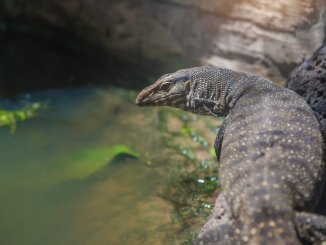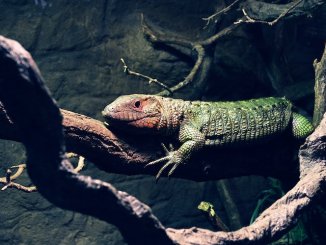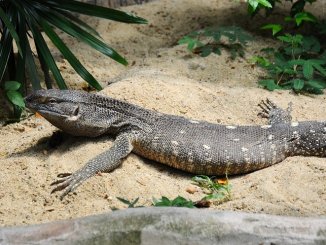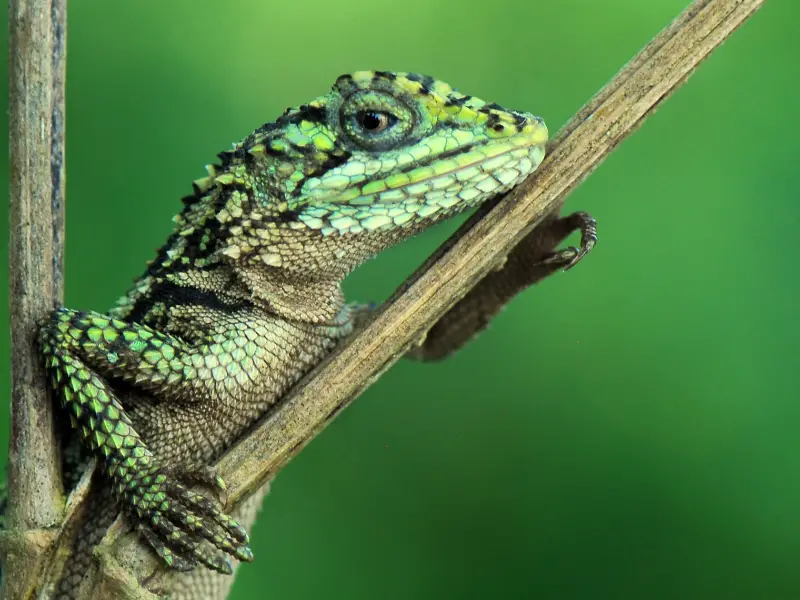
A neon tree dragon is a medium-sized lizard native to China. As their name suggests, these lizards are known for their bright “neon” coloring, in the form of two green stripes down their backs.
These dragons also love trees, as they are native to lowland jungles.
Neon tree dragons are quite rare to come by, so they can be an exciting and impressive lizard to keep.
However, it’s important to ensure these lizards are set up in the right environment and that they are fed the right diet.
Once you master this, caring for neon tree lizards is pretty straightforward, although they can be quite temperamental in the kind of environment they prefer.
Neon Tree Dragon Overview
| Common name | Neon tree dragon, Japalura splendida, Japalura tree dragon, banana split mountain lizard, Chinese tree dragon, dragon agama, green-striped tree dragon |
| Scientific name | Diploderma splendidum |
| Natural habitat | Yangtze River Basin, southwestern China |
| Adult size | 10 - 12 inches |
| Average lifespan | 8 - 10 years |
| Diet | Primarily insectivorous |
| Housing | Humid terrarium (20-gallon) with strong UVB light |
| Experience | Intermediate |
Origin
The neon tree dragon (Diploderma splendidum) is an agamid lizard that originates from the Yangtze River Basin in southwestern China. These lizards are also found in parts of Australia.
Neon tree dragons are native to the lowland jungles in China, with the lizard thriving in temperate yet humid conditions.
These reptiles are usually found as wild-caught imports, which means they often come with intestinal parasites or infectious diseases.
It’s important to have your neon tree dragon checked for parasites if you plan to bring one home as a pet.
Appearance And Behavior
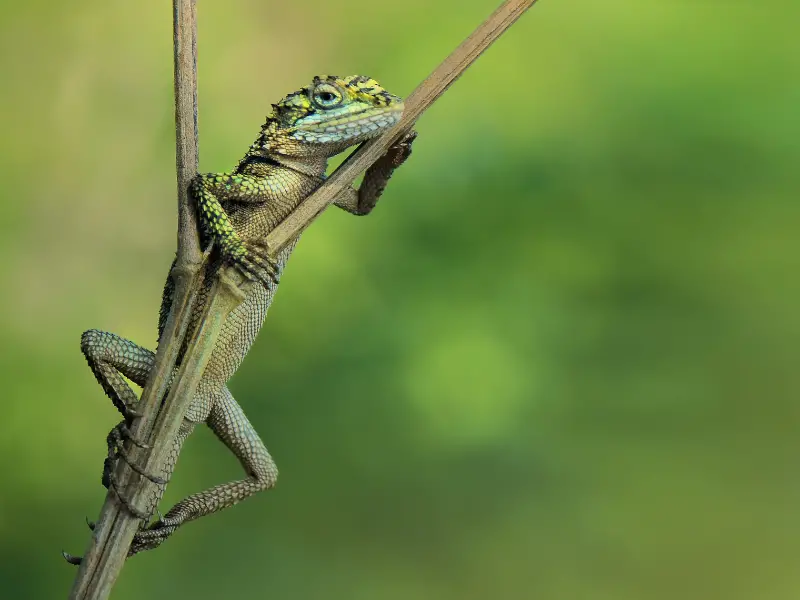
The neon tree dragon is also commonly called a green-striped tree dragon due to the broad light green stripes on each side of the lizard’s back.
This is the defining feature of a japalura tree dragon. The top of the lizard’s head is covered in medium-sized juxtaposed scales, while there are three or four slightly enlarged subconical scales on its snout that form a slight ridge.
The lizard has a small crest, made up of about eight or nine denticulate scales. These lizards also have a very small dorsal crest. Its back and sides are covered in strongly-keeled scales that vary in size.
These lizards have dark brown heads marked with yellow spots and streaks. They have a dusky belly and tail, and small dark eyes with a yellow rim.
Males usually have more vivid coloring than females. Both genders have dewlaps, but only males have large cheek pouches and hemipenal bulges.
Males also have uneven head stripes, while females have even head stripes. Generally, males will have larger heads and longer legs than females.
Size And Lifespan
Adult neon tree dragons typically grow to about 10 – 12 inches in length.
When given proper care, a healthy Chinese tree dragon will usually live for around 8 – 10 years in captivity.
Temperament
Neon tree dragons are very territorial, and they can quickly get stressed under crowded conditions. This means they’re best kept as solo creatures, or housed with no more than two lizards in a 20-gallon tank.
If you house two lizards together, make sure there are sufficient hiding spots for the lizards. Being so territorial, your dragons will enjoy the option of hiding behind leaves and plants. Try not to keep two males together in the same tank.
A green-striped tree dragon is usually quite skittish when handled, which is typical for a lizard of its size. Because these lizards are rarely sold in stores and are usually wild-caught, they are not used to handling. However, some lizards have been known to warm up to handling and will even take food from the hand.
Housing Neon Tree Dragons
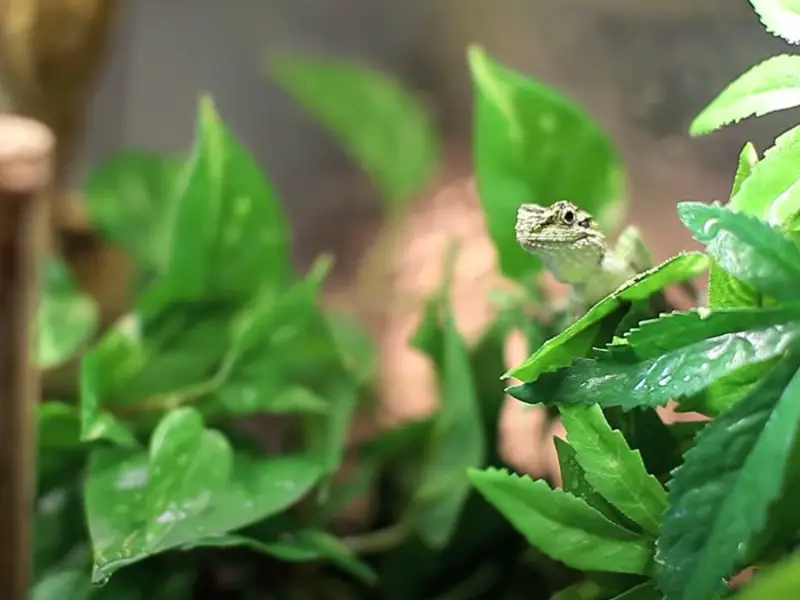
Neon tree dragons are native to the lowland jungles of southwestern China and are usually wild-caught.
This means it’s important to create a realistic “natural” environment when keeping them in captivity. These dragons are best kept in a carefully-managed terrarium.
Neon tree dragons require high levels of humidity, so wrapping the back and sides of the enclosure can help retain humidity. The enclosure will need frequent spraying to keep the humidity levels right.
If a neon tree dragon does not get enough humidity in its environment, it will retain shed skin. However, these lizards also need enough fresh air to avoid skin infections so do not keep the humid air too trapped in.
Enclosure Size
Green-striped tree dragon dragons do best in enclosures that offer more space. The more space the better, as these lizards are highly territorial. A 20-gallon enclosure is ideal for an adult banana split mountain lizard.
These dragons love to climb and make use of their space, so having a chameleon-style mesh cage is ideal for helping them reach every corner of their enclosure.
These lizards will continually run into clear walls, so glass or plastic enclosures are not recommended.
Lighting
Neon tree dragons require plenty of UVB light. Roughly 10 hours of UVB light per day is ideal. The UVB light helps to process their calcium, which enhances their colors.
Try to provide plenty of different angles, heights, and positions within the enclosure, so that the lizard can choose its preferred position underneath the UVB lamp.
It’s also important that these lizards have a basking lamp that can reach 95°F.
Temperature And Humidity
As mentioned, neon tree dragons require high-humidity environments. The base humidity should be around 60% – 80%, with higher humidity in bursts.
It’s a good idea to mist the enclosure once a day for these bursts. We recommend keeping a hygrometer in the enclosure to keep an eye on humidity levels.
Neon tree dragons will need a basking spot in the enclosure that reaches around 90-95°F during the day.
A basking lamp can provide this. It’s important that the temperature away from the basking lamp gradually lowers. Suitable night temperatures for these lizards can drop down to 60°F.
Substrate And Decoration
These dragons can be very active in their environments and love having as many rocks, plants, leaves, and branches as possible.
The more elements you include in their enclosures, the more opportunities they will have to explore.
Neon tree dragons are known to use anything and everything in their enclosure – even hanging parrot toys.
They are mostly arboreal, meaning they prefer to be up in the trees and off the ground so make sure you have some branches they can climb on.
They also love water, so make sure you include a large shallow water bowl for drinking and soaking. Try to add some stones to the water, as these lizards prefer to drink from the water at an angle.
You’ll need to place the water source away from the hot basking spot. You can place this on the floor or at an elevation.
Lastly, it’s a good idea to include a few shallow nests in the terrarium – especially if you plan to breed the lizards.
Cleaning
It’s important to regularly clean your lizard’s tank in order to manage bacteria. The best approach is to clean the tank with hot water, although you can sanitize with a 10% bleach solution (and then rinse with hot water).
Neon tree dragons enjoy spending time in the water, so clean their water source regularly.
Neon Tree Dragon Care
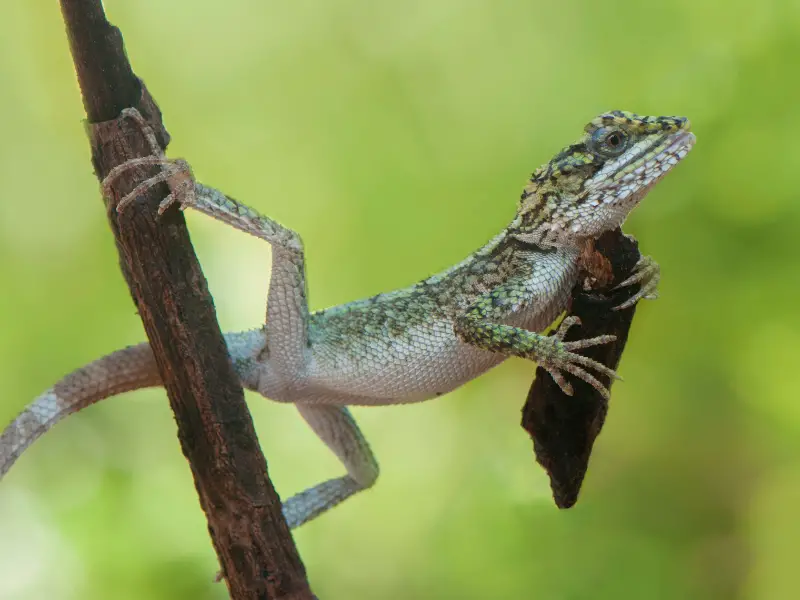
The main care requirements of keeping a neon tree dragon are maintaining the right heat and humidity, and ensuring the dragon is fed the right diet. This will often involve a calcium supplement.
Food And Water
A neon tree dragon prefers a varied diet of insects. They enjoy crickets, grasshoppers, roaches, and other soft-bodied insects. These dragons also love safe flying insects, like craneflies and moths.
Avoid feeding them flies and mealworms. You can occasionally feed these lizards some fruits and greens in minimal amounts.
You can feed these lizards every second day, with an average adult eating about 5 crickets per feeding. Providing green-striped tree dragons with a calcium supplement is a good idea – especially for females.
Neon tree dragons love water, so be sure to always provide a clean water source for them to bathe and drink from. However, they don’t enjoy drinking from still water, so you may need to add a small bubbler.
Hatchlings and infants grow fast and will eat every day. Feed them as many properly sized insects dusted in calcium powder as they will eat.
Handling
Since most green-striped tree dragons are caught in the wild, they are usually quite skittish. If you find a rare captive-bred one, it should be more relaxed when it comes to handling.
It is possible for some wild-caught lizards to become comfortable with handling over time though.
As a general rule, it’s best to avoid handling these lizards. Their active nature means they are great fun to watch.
Common Health Issues
As mentioned, these reptiles are usually wild-caught, so they’re prone to parasites. Be sure to have this checked by sending a fecal sample to a vet.
This species also requires a lot of calcium, and are often prone to Metabolic Bone Disease (MBD), which can be identified by crinkled tails.
You can help treat this with a proper diet and enough calcium. Neon tree dragons are known to eat calcium dust straight out of a dish so it should be easy to treat.
Another thing to note is to keep a close eye on skin shedding with neon tree dragons. Their rough and clingy scales can make it tricky for them to fully shed their skins – even in high-humidity environments.
A good way to assist with shedding is to bathe the lizard every day with a small tub and hand towel. Leave the lizard to move around in the lukewarm water covered up to their elbows.
Breeding
When breeding a neon tree dragon, the male will court the female. He bobs his head and chest and quickly darts after her. If the female accepts, she will bob her head in recognition. This will last a few days.
A male should give the female a break, and only perform the courtship ritual in small bursts. If the male does not give the female a break you may want to keep the male alone.
After mating, the female will develop eggs and deposit them in a substrate environment, like soil or coconut fiber.
She will usually deposit 4 to 12 tiny eggs which incubate from 40 to 60 days. These eggs need to be kept at a consistent temperature of around 80°F.
Choosing And Buying A Neon Tree Dragon
Neon tree dragons are nearly always wild-caught, which can come with many complications.
It’s important always to try to buy these lizards from a reputable breeder if possible. Although, finding a green-striped tree dragon in a store is rare.
If you do buy a neon tree dragon, be sure to check them for any parasites, as there’s a good chance these lizards were wild-caught. Also pay attention to crinkled tails or dull colors, which could mean a lack of calcium.

